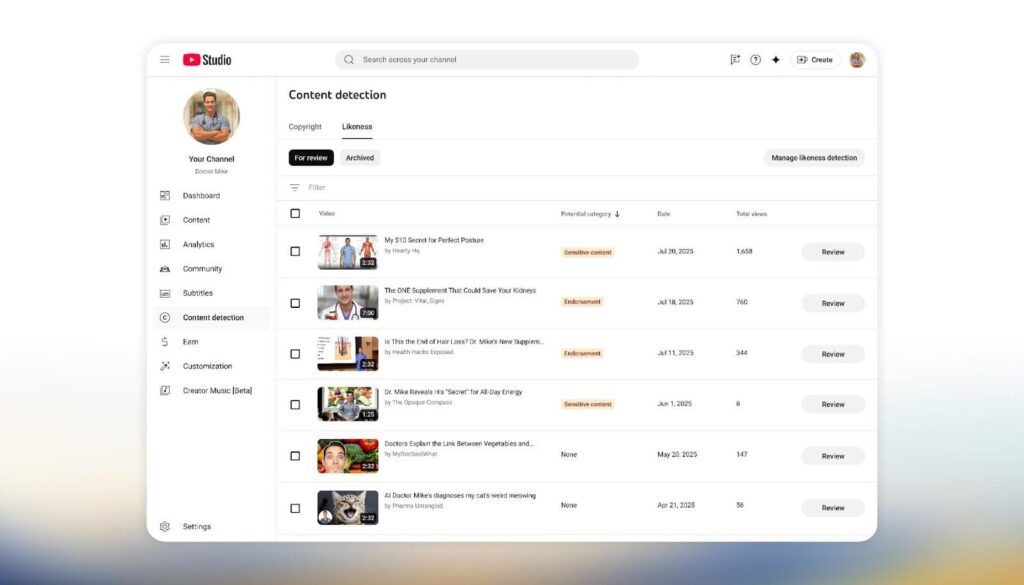In a move that could redefine digital authenticity and online accountability, YouTube has officially launched its AI-powered Likeness Detection Tool, aimed at protecting creators from unauthorized use of their faces and voices in synthetic or manipulated videos. The rollout on October 22, 2025, comes as the Government of India simultaneously introduced stringent new proposals requiring mandatory labeling of AI-generated content, marking a significant step toward regulating deepfakes and ensuring online transparency.
Together, these developments signal a new era for the creator economy one where identity protection, AI transparency, and ethical technology use become non-negotiable pillars of the digital ecosystem.
The Core of the Update: YouTube’s AI Shield for Creators
The new Likeness Detection Tool leverages machine learning to detect videos that mimic or replicate a creator’s facial appearance or voice without consent. Available initially to members of the YouTube Partner Program, the tool is designed to help creators identify, review, and request removal of such unauthorized videos after verifying their identity.
YouTube confirmed that the tool operates through advanced similarity matching algorithms that analyze millions of frames and audio samples. When the system finds a potential match, it alerts the creator within their YouTube Studio dashboard, under a new section titled “Likeness Detection.”
After verifying that the flagged content indeed features their likeness, creators can request immediate removal under YouTube’s privacy violation policy. Once verified, the platform commits to removing infringing content within a specified time frame.
According to a company spokesperson, this innovation represents “a major leap forward in identity protection for digital creators”, especially as deepfake technologies become increasingly realistic and accessible.
Why YouTube Is Taking This Step Now
YouTube’s parent company, Google, has been vocal about the risks of AI-generated misinformation, particularly during sensitive times like elections or public crises. The proliferation of deepfakes hyperrealistic but fabricated videos has triggered growing concern among regulators, creators, and audiences alike.
In recent months, several viral incidents have shown how AI can convincingly replicate a person’s face or voice, leading to fraud, character assassination, or misinformation. Instances of fake celebrity endorsements, manipulated political videos, and AI-cloned influencers have prompted global platforms to act preemptively.
By introducing the Likeness Detection Tool, YouTube is signaling its intent to lead the fight against deepfake misuse while maintaining a balance between creative freedom and ethical responsibility.
India’s Bold Step: Mandatory AI Content Labels
Coinciding with YouTube’s rollout, India’s Ministry of Electronics and Information Technology (MeitY) has unveiled proposed amendments to the Information Technology Rules, 2021, to strengthen oversight of AI-generated and synthetic content.
Under the proposed changes:
- Platforms will be required to label AI-generated content with visible markers that cover at least 10% of the video frame or its duration in the case of audio.
- Each piece of synthetic media must include unalterable metadata that confirms whether it was created using artificial intelligence tools.
- These labels and markers must remain tamper-proof and verifiable, even if the content is reshared or embedded elsewhere.
- Platforms failing to comply could face penalties and loss of “safe harbor” immunity, which protects intermediaries from user-generated content liabilities.
- The proposal also emphasizes stricter monitoring during election periods, when the spread of AI-generated misinformation could have severe consequences for public opinion and democracy.
According to MeitY officials, these measures are designed to “ensure transparency, protect users from deception, and promote responsible AI usage” in the country’s rapidly evolving digital landscape.
A Global Concern: Deepfake Threats Rising Worldwide
While India’s action is among the most comprehensive regulatory efforts to date, concerns over AI misuse are mounting globally.
In the United States and Europe, policymakers are debating AI labeling frameworks similar to India’s, while China already mandates real-name verification and labeling for AI-generated videos. The European Union’s AI Act, set to take effect in 2026, also includes provisions requiring content creators to disclose when media has been synthetically produced or altered.
YouTube’s latest move therefore positions it ahead of many competitors, creating a global precedent for identity detection in the creator economy.
Cybersecurity experts have long warned that deepfakes could become the next major vector of disinformation, especially when combined with social media virality and generative AI tools capable of producing near-perfect replicas of real people.
How the Tool Works Behind the Scenes
Though YouTube has not disclosed the precise algorithms used, early beta testers report that the Likeness Detection Tool uses a combination of biometric recognition models and audio pattern mapping to locate potential impersonations.
When the system identifies a likely match, it categorizes it by confidence score (e.g., 70%, 85%, 95%), allowing creators to manually review and confirm authenticity. It can detect not just identical replications, but also AI-altered compositions — for instance, when a person’s face is merged into another scene or their voice is re-synthesized to say different words.
Once the creator verifies the match, YouTube’s moderation team reviews the takedown request, balancing it against fair use, parody, or transformative content exceptions. In cases of confirmed identity misuse, YouTube removes the content and may issue strikes or suspensions against the uploader.
The feature is currently limited to creators enrolled in the Partner Program, which includes monetized channels with a verified history. YouTube says it plans to expand access to all creators by early 2026.
Industry and Expert Reactions
Digital rights advocates, cybersecurity analysts, and creator groups have largely welcomed the move.
Dr. Neha Sharma, an AI ethics researcher at the Indian Institute of Technology Delhi, calls the dual developments “a landmark moment for the responsible evolution of AI.”
“We’re seeing the world’s biggest video platform and one of the fastest-growing digital nations acting simultaneously to tackle the same problem — synthetic deception. It shows how public policy and private innovation can converge to build trust.”
On the other hand, some free-speech groups have cautioned that over-regulation or algorithmic bias in likeness detection could risk false positives, potentially penalizing satire, commentary, or transformative art.
YouTube has assured that creators will retain full review control and can appeal any incorrect detections. Transparency reports are expected to accompany the feature’s global rollout, detailing detection accuracy and takedown statistics.
The Economic and Social Impact
For creators, the tool represents a new layer of brand security. As influencer marketing, digital endorsements, and virtual celebrity partnerships grow into a multi-billion-dollar industry, protecting one’s image has become as vital as protecting copyright.
A recent study by CyberSafe India (2025) found that nearly 1 in 5 Indian creators had encountered impersonation or AI misuse of their likeness within the past year a figure expected to rise sharply as generative AI tools become more user-friendly.
For viewers, visible AI labels on videos will foster greater media literacy. Users will gradually learn to distinguish between authentic footage and synthetic media a critical skill in an era of information overload.
Meanwhile, advertisers and brands are likely to view YouTube’s initiative as a trust-reinforcing measure, potentially making the platform safer for commercial collaborations and sponsorships.
India’s AI Policy Landscape
India’s proposed amendments to the IT Rules, 2021 are part of a broader digital governance effort that includes the Digital India Act, currently under development. The government has emphasized that emerging technologies must operate within frameworks that “prioritize safety, accountability, and transparency.”
The country’s proactive approach is being closely watched globally. India’s massive digital population over 850 million internet users makes it one of the largest testing grounds for AI governance policies.
If enacted, the labeling mandate could force global tech companies like Meta, X (formerly Twitter), Instagram, and TikTok to adopt similar transparency standards in India, reshaping their global AI compliance strategies.
Balancing Innovation and Regulation
The intersection of YouTube’s innovation and India’s regulation underscores a central challenge of the AI era: how to encourage creative and beneficial uses of AI while curbing its misuse.
Experts believe both developments the Likeness Detection Tool and India’s labeling framework are complementary, not contradictory.
While YouTube’s tool empowers individuals to protect themselves from impersonation, India’s policy ensures that every user can see when content is artificially generated, regardless of who made it. This dual approach creates both preventive and informative barriers against AI deception.
Global Outlook: The Future of AI Accountability
Following YouTube’s announcement, industry watchers expect other platforms such as Instagram, TikTok, and Meta to introduce similar AI-detection or labeling tools. Several independent startups are already developing open-source frameworks to embed digital watermarks or blockchain-based authenticity tags in multimedia files.
AI governance is becoming one of the defining challenges of the decade. From Hollywood actors protesting deepfake voice theft to politicians warning of election interference, the pressure to regulate synthetic media is mounting.
As AI continues to evolve, tools like YouTube’s Likeness Detection may soon become standard security features as essential to content creation as copyright claims or monetization controls.
A Turning Point for the Digital World
The combined effect of YouTube’s technological advancement and India’s regulatory momentum marks the beginning of a new era of digital accountability.
- For creators, it means greater control over their identity.
- For viewers, it means clearer visibility into what’s real and what’s artificial.
- For platforms, it’s a call to innovate responsibly.
As AI blurs the line between the authentic and the artificial, one thing remains clear: the future of online media will belong to platforms and governments that put transparency first.
Whether it’s through detection tools, content labels, or metadata verification, the digital landscape is being reshaped to prioritize truth and to protect the very essence of human authenticity in an algorithmic age.
Related News: Read More





